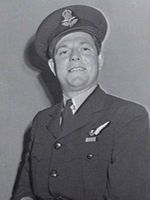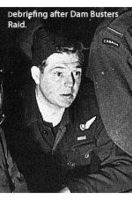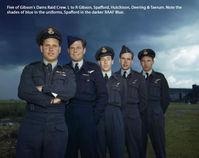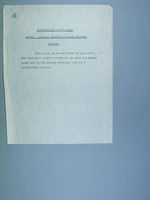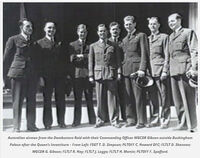Flying Officer Frederick Michael SPAFFORD
Flying Officer Frederick Michael SPAFFORD DFC DFM
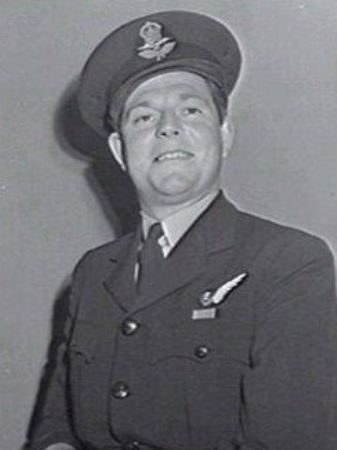
Frederick Michael Spafford, [1918-1943], RAAF air force officer, was born on the 16th June 1918 in North Adelaide, the only child of James Michael Burke [d.1923], a tannery foreman, and his wife Vida Muriel, nee Spafford [d. 1926], both South Australian born. Little evidence survives of Fred’s childhood and education. On the 19th September 1929 he was adopted by his maternal grandfather Frederick Blaker Spafford, a 70-year-old ironworker, and given his surname. In time Fred worked as a fitter.
On the 14th September 1940 Frederick Michael Spafford enlisted in the Royal Australian Air Force. His grandfather had died on the 25th March of that year and Fred named his uncle Walter James Spafford [1884-1962], South Australia’s Director of Agriculture, as his next of kin.
Reference- NAA Digitized Service Records On the 15th September Fred was posted to No. 1 Initial Training School at Somers, Victoria and a month later to No. 1 Wireless Air Gunners School, Ballarat. Here he completed Course 6 Wireless Operator and then the Air Gunner component of the Course at No. 1 B.A.G.S. Evans Head, N.S.W. graduating on the 2nd of May 1941. After his training as a W.A.G. Spafford was sent to England in August 1941 as part of the Empire Air Training Scheme. He was then remustered to the trade of a ‘Temporary Air Bomber’.
Frederick Spafford was sent to No. 5 Bomber group, R.A.F., in the East Midlands of England where he spent short periods with a number of units. In May 1942 he was posted to No. 50 Squadron, R.A.F., with which he flew in Manchesters and later Lancasters as a specialist bomb-aimer. The four- engine Lancaster bomber became the principal weapon in Britain’s air offensive against Germany at night. Following fifteen sorties, Spafford was awarded the Distinguished Flying Medal in October for his skill and ‘praiseworthy example’. He was commissioned in January 1943.
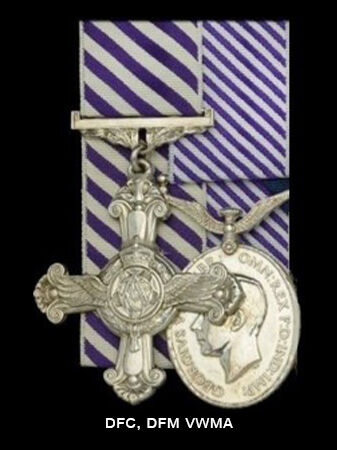 Having survived his tour of thirty operations, Spafford could have expected a respite from combat, but in March he was invited to join an elite R.A.F. squadron, No. 617, being formed for a special mission against dams in the Ruhr and Weser valleys. [Sir] Barnes Wallis had designed a new type of mine or ‘bouncing bomb’ able to skip over defensive torpedo-nets and explode at depth against the wall of a dam.
Having survived his tour of thirty operations, Spafford could have expected a respite from combat, but in March he was invited to join an elite R.A.F. squadron, No. 617, being formed for a special mission against dams in the Ruhr and Weser valleys. [Sir] Barnes Wallis had designed a new type of mine or ‘bouncing bomb’ able to skip over defensive torpedo-nets and explode at depth against the wall of a dam.
On the night of May 16th Spafford flew with Wing Commander Guy Gibson, who led a formation of nineteen Lancasters in attacks on the Mohne, Eder and Sorpe dams. Bombs had to be released at the dangerously low height of 60 ft [18 m.] at a set speed, line and distance from the wall of each targeted dam. Gibson regarded Spafford [whose nick-name was ‘Spam’] as the’ best bomb-aimer there is’. The Mohne and Eder dams were successfully breached, flooding a large stretch of country. The daring and spectacular ‘Dam Buster’ raid was acclaimed as a triumph, boosting allied morale. Interviewed by the press and on the radio, Spafford described the secrecy and hazards of No. 617’s training for low-level flying, the elaborate briefings, and the attack which was carried out in bright moonlight against enemy fire.
The hugely successful WW2 movie ‘The Dam Busters’ was made about these events with an actor portraying Frederick [Spam] Spafford.
Gibson was awarded the Victoria Cross and, among the other decorations presented at Buckingham Palace, Spafford received the Distinguished Flying Cross. Five feet eight and a half inches [174 cm] tall, stockily built and squared shouldered, with a fair complexion, hazel eyes and brown hair, he had an open face and wore his cap at a rakish angle. Crew mates spoke of his nonchalance in the face of danger.
Despite high loses in the dams raid-nine of the Lancasters which had set out did not return-No. 617 Squadron was kept in commission for similar tasks. On the night of 15/16th of September 1943 the British attacked the Dortmund-Ems Canal, using substantially the same tactics. In patchy fog and poor visibility, and against alert defenses, five of the eight attacking aircraft were shot down. Hit by flak, Spafford’s plane caught fire, crashed, and blew apart on the ground. There were no survivors.
Spafford is buried at the Reichswald Forest War Cemetery, Kleve, Nordrhein-Westfalen, Germany.
He was 25 years old.
Spafford was posthumously promoted Flying Officer.
This article was published in Australian Dictionary of Biography, Volume 16, [MUP] 2002
Reference- National Archives of Australia Digitized Record of Frederick Michael Spafford
Links –
Click here for the biography of Frederick Michael Spafford
Click here for the Australian War Memorial
Click here for the Dambuster Blog
Click here for the RSL article
Click here for WW2 Talk
Click here for the National Archives of Australia

